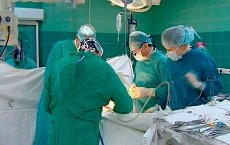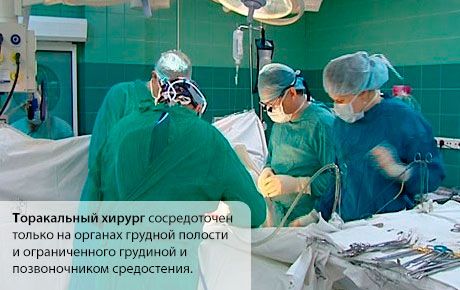New publications
Thoracic surgeon
Last reviewed: 03.07.2025

All iLive content is medically reviewed or fact checked to ensure as much factual accuracy as possible.
We have strict sourcing guidelines and only link to reputable media sites, academic research institutions and, whenever possible, medically peer reviewed studies. Note that the numbers in parentheses ([1], [2], etc.) are clickable links to these studies.
If you feel that any of our content is inaccurate, out-of-date, or otherwise questionable, please select it and press Ctrl + Enter.

There are many specializations in modern clinical surgery. One of them is thoracic surgery, which deals with pathologies of organs located in the thoracic region, i.e. in the chest area. Several decades ago, cardiac surgery, vascular surgery and mammology emerged from thoracic surgery. So today, a thoracic surgeon focuses only on the organs of the chest cavity and the mediastinum limited by the sternum and spine.
Who is a thoracic surgeon?
A thoracic surgeon is the main specialist in the surgical treatment of diseases of the human respiratory system (bronchi, trachea, pleura, lungs, diaphragm), pathologies and diseases of the esophagus, as well as in providing surgical care for various injuries to the chest and the organs located in it.

Like a surgeon of any other specialty, a thoracic surgeon cannot stand at the operating table without fundamental medical knowledge and proven professional skills.
Who is a thoracic surgeon? This is a doctor who is proficient in all modern methods of diagnosing diseases of the chest organs and objectively assessing the degree of damage to a particular organ and the patient's condition. It is the thoracic surgeon who makes the decision on the most effective and safe surgical intervention.
When should you see a thoracic surgeon?
Pay attention to the main signs of any pathologies in the chest area, which is exactly the case when you should contact a thoracic surgeon. Such symptoms primarily include pain localized in the chest and esophagus; saliva with blood; difficulty swallowing, disruption of food passage through the esophagus, etc.
However, it should be borne in mind that a thoracic surgeon does not receive patients in a polyclinic, since surgical treatment of the chest organs is performed in a hospital setting. Therefore, the patient receives a referral to this specialist from the doctor to whom he addressed his complaints.
In urgent and acute cases, patients (or injured people) are brought to the thoracic surgery department by ambulance...
Therefore, the question of what tests need to be taken when visiting a thoracic surgeon remains open. Although, if there is a referral for examination or treatment in a hospital, the patient has a medical history and the latest results of general clinical studies - blood tests, urine tests, X-rays, etc.
What diagnostic methods does a thoracic surgeon use?
To prescribe surgical treatment for a particular disease of the chest cavity and mediastinum, it is necessary to establish or confirm the diagnosis. In addition to examination, collection of anamnesis and data recorded in the medical history, a clinical examination of the patient should be prescribed.
What diagnostic methods does a thoracic surgeon use? First, the patient takes all the necessary tests (general blood, urine, feces, sputum) - to conduct clinical and laboratory studies.
Also used to determine the diagnosis are:
- radiography,
- ultrasound examination (ultrasound),
- spiral computed tomography (SCT),
- positron emission tomography (PET),
- interventional sonography,
- angiography,
- autofluorescent and fluorescent bronchoscopy,
- thoracoscopy,
- arthroscopy,
- pleural puncture,
- biopsy.
What does a thoracic surgeon do?
Many existing diseases of the chest organs can be treated conservatively, that is, with medication. But there are diseases for which medication is powerless. And then they resort to surgery, that is, surgical treatment. And this is what thoracic surgeons do.
What else does a thoracic surgeon do? To obtain complete information for an accurate diagnosis, he/she conducts a thorough examination of patients, draws up an examination plan for each patient, prescribes all necessary procedures and medical manipulations. Determines the tactics of surgical treatment, carries out preoperative preparation of patients and performs the necessary operations. Surgical treatment is resorted to only in the absence of a real opportunity to cope with the pathology by conservative methods, as well as when the development of complications leads to life-threatening consequences, for example, a breakthrough of a lung abscess into the pleural cavity, pulmonary hemorrhage or the formation of fistulas.
Today, in thoracic surgery, modern endoscopic and laparoscopic minimally invasive surgical treatment methods, microsurgical and laser technologies have come to the aid of the traditional scalpel. They allow not only to reduce the size of the surgical field, but also to significantly facilitate access to the organs of the chest cavity, which are located behind the ribs. This reduces the recovery time of patients after the most complex surgical interventions.
In addition, the thoracic surgeon prescribes drug treatment in the postoperative period and monitors the condition of patients in order to prevent complications.
What diseases does a thoracic surgeon treat?
According to thoracic surgeons themselves, most often they have to deal with diseases of the lungs and bronchi - purulent-inflammatory (abscesses of various etiologies, bronchiectasis, emphysema), lung tumors, cystic formations, as well as tuberculosis, which accounts for at least 80% of all cases.
Esophageal pathologies that require surgical treatment include: diverticula (protrusion of the wall) of the esophagus, purulent or phlegmonous inflammation of the walls of the esophagus (esophagitis); benign and malignant neoplasms of the thoracic esophagus, swallowing disorder (achalasia), esophageal-tracheal fistulas, burns and cicatricial stenosis of this part of the digestive tract.
Also included in the list of diseases treated by a thoracic surgeon are:
- pathologies of the pleura and pericardium (tissue lining of the heart, aorta and pulmonary trunk) - acute and chronic empyema (accumulation of pus) of the pleural cavity, cysts and tumors of the pleura and pericardium, pericarditis and pericardial diverticula.
- diseases of the mediastinum - neoplasms of the mediastinum and trachea, accumulation of lymph in the pleural cavity (chylothorax), acute and chronic inflammation of the mediastinal tissue (mediastinitis), persistent narrowing of the lumens (stenosis) of the trachea and bronchi;
- diseases of the diaphragm and chest wall - hernias, cysts, tumors and injuries; chondritis and perichondritis; purulent inflammation of bone tissue (osteomyelitis) of the ribs, shoulder blades and sternum.
- pathologies of the thymus and thyroid glands.
A thoracic surgeon is responsible for removing foreign objects from the esophagus, as well as various injuries to the chest organs.
Advice from a thoracic surgeon
Most often, foreign bodies get into the respiratory tract (larynx, trachea, bronchi) of children under four years of age: they constantly put something in their mouth, and often small objects or pieces of food cause blockage (obstruction) of the upper respiratory tract. This is very dangerous and can lead to asphyxia - increasing suffocation, which in a couple of minutes leads to death. According to medical statistics, the mortality rate in such cases reaches 2-3%.
By the way, this also happens to adults, because you can simply choke while eating. A reflex cough (even to the point of vomiting) and suffocation immediately begins, during which the face turns red and is covered in cold sweat. The most dangerous localization of a foreign body is the larynx and trachea.
Remember the advice of a thoracic surgeon on providing first aid if a foreign body enters the respiratory tract:
- You cannot waste precious time examining the oral cavity or trying - in most cases unsuccessfully - to remove the stuck object with tweezers or fingers.
- Turn the victim over onto his stomach and bend him over the back of a chair or armchair head down, or a child over your thigh. Then with an open palm (not a fist!) hit him on the back between the shoulder blades several times.
- If the stuck object or piece of food does not come out, you need to stand behind the victim, clasp him with both hands so that your clasped hands are below the victim's xiphoid process (the xiphoid process is the lower, free end of the sternum - a flat bone in the middle of the front wall of the chest). In this position, you need to sharply press hard on the diaphragm (the muscle along the lower edge of the ribs) and simultaneously hit the victim on your chest.
- In the case of a child, this method of freeing the trachea from a foreign body should be used as follows: place the child on his back on something hard, tilt the head back, lift the chin; place two fingers of one hand on the child's upper abdomen - between the navel and the xiphoid process; quickly and strongly press deep and upward. The technique can be repeated four times.
- The second option: sit the child on your lap, place the fist (thumb up) of one hand on the middle of his stomach, hold the child by the back with the other hand. Quickly, strongly and deeply press the fist on the stomach - towards the ribs.
- If the victim loses consciousness, he should be placed on his right side and hit on the back several times with the palm of the hand.
Sometimes the victim undergoes an emergency tracheotomy - opening the trachea with the introduction of a special tube into its lumen to prevent the person from suffocating. This operation is performed not only by a thoracic surgeon, in case of life-threatening asphyxia it is performed by ambulance doctors even without anesthesia.
